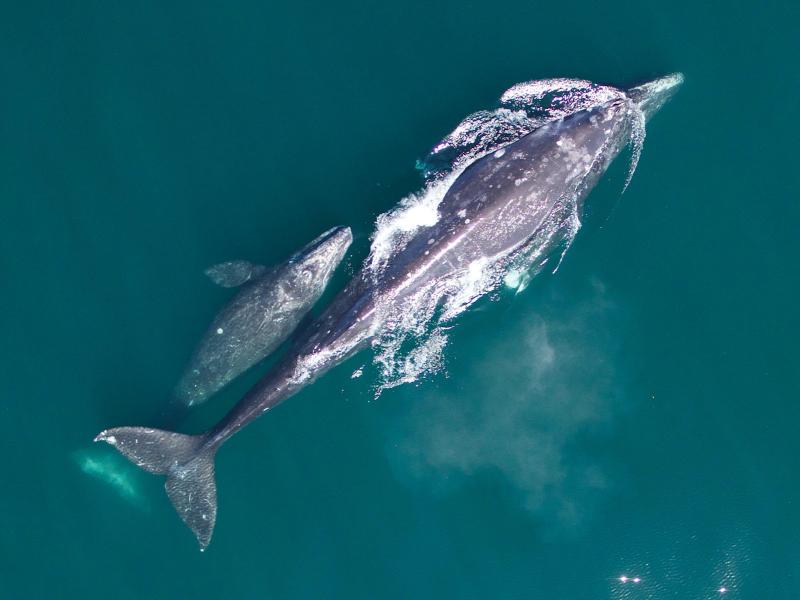Almost twice as many gray whale calves swam north with their mothers to their Arctic feeding grounds this spring compared to last year, according to a new count completed by NOAA Fisheries’ Southwest Fisheries Science Center.
The results suggest that the eastern North Pacific population of gray whales that migrate along the West Coast may be stabilizing after several years of declines. NOAA Fisheries declared an Unusual Mortality Event in 2019 due to an increase in strandings that nearly cut their numbers in half. The increase in the estimated number of calves migrating north adds to other positive signs for the population. We have also seen higher numbers of mother-calf pairs in Mexican wintering lagoons and fewer whales stranding and dying on their migration north.
“This is a positive data point, but it is only a small improvement that we need to keep monitoring,” said Aimée Lang, who led the spring calf count. Researchers at Piedras Blancas on the central California coast estimated that 412 female gray whales swam north with calves this year. Gray whales undertake one of the longest migrations of any species.
That is nearly twice the estimated all-time low of 217 mother-calf pairs migrating north last year, which was the fewest since surveys began in 1994. However, it remains far below the estimate of roughly 1,500 gray whale calves in 2016, when the gray whale population contained nearly 27,000 whales. A count last winter estimated that the total population had fallen to about 14,500 whales.
Researchers from the Southwest Fisheries Science Center typically count gray whales during their southbound migration on a cycle of 2 out of every 5 years. However, they have completed three counts in the past 4 years and will complete another count in the winter of 2024 to track the gray whale population trajectory.
Strandings Spiked in 2019
Continued strandings included emaciated whales that suggested some were not finding sufficient food during their summer feeding seasons in the Arctic. The whales build fat reserves in the summer to sustain their winter migration south to Mexico and then back to the Arctic again.
Some whales may still be having trouble, though. John Calambokidis of Cascadia Research Collective in Washington noted that 13 gray whales have stranded in the state in 2023, approaching the 15 that stranded in 2022. “So no real sign of a drop in strandings in Washington anyway,” he said. This number is significantly lower than strandings in Washington in 2019 when 34 whales stranded, although higher than historic baselines.
“I think there are still some important mysteries going on here and the role of conditions in the Arctic is one,” said Calambokidis, who is part of a team of scientists probing the causes of the UME.
Science Team Analyzing Data
The science team is analyzing stranding data and necropsy results to identify factors contributing to the deaths, such as changes in the availability of food in the Arctic, said Deborah Fauquier, Veterinary Medical Officer in NOAA Fisheries’ Office of Protected Resources who coordinates the UME response. The team has so far identified several likely contributing factors including:
- Ecosystem changes in Arctic feeding areas that may contribute to malnutrition
- Vessel strikes
- Entanglements and predation by killer whales
The team will determine whether the increased calf estimate and recent positive signs from Mexico warrant closing the UME.
A previous UME depressed gray whale numbers and calf counts in 1999 and 2000, but the population rebounded in the following years. The current UME has lasted several years longer, with a larger decline in population size. As outlined by the Marine Mammal Protection Act, UMEs continue until the resulting investigation determines that its causes have been resolved or become persistent.




